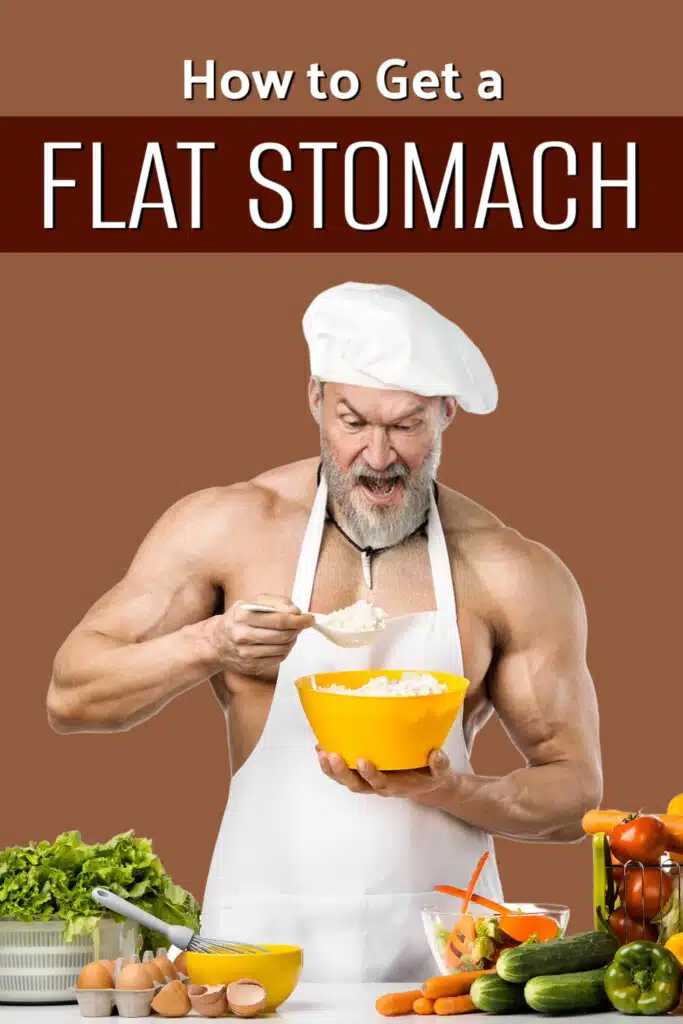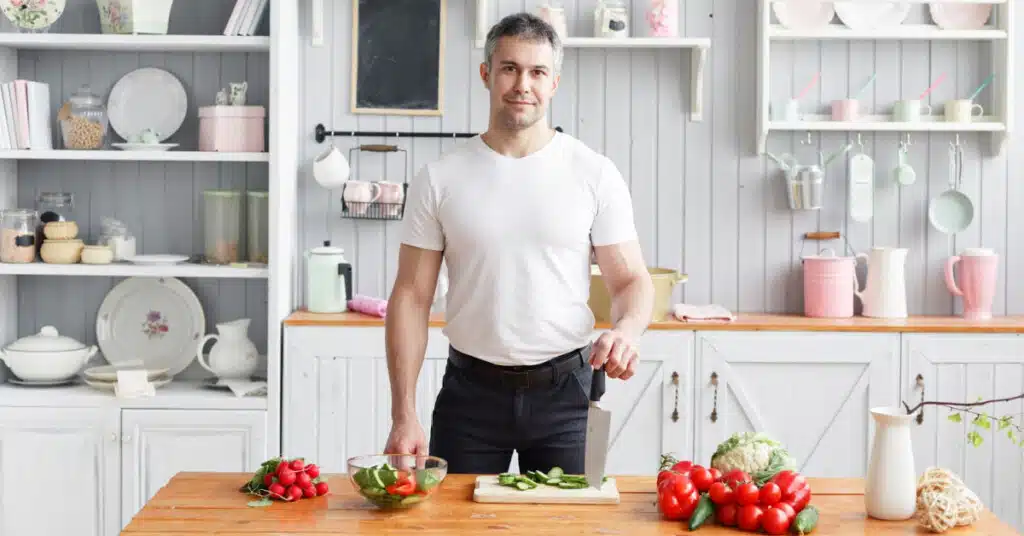Would you like a flat stomach?
Here are four solutions for getting a trim and firm midsection.
I’ve also included a video that should prove helpful.
Right from the get-go, it’s crucial to understand that basal metabolic rate (BMR) represents the calories your body needs to maintain essential physiological functions at rest.
These functions include breathing, circulation, and muscle cell maintenance.
In other words, BMR is the energy expended by your body to keep you alive and functioning even when you’re not physically active.
To get a flat stomach, the first thing you want to do is to begin to raise your metabolic rate.
1. Lift Your Basal Metabolic Rate
Want to see abdominal definition when you face the mirror? If so, it will help to increase the number of calories your body utilizes while at rest:
- You do that by developing muscle tone.
- Because muscle cells are like little fat-burning furnaces – they like to chew up calories all the time.
- And resistance training can be beneficial because it develops muscle.
And don’t worry about getting too bulky.
Building thick, solid muscle is actually quite difficult to do. You’d be very lucky if you were to put on even 8 pounds of muscle, and usually, only professional athletes can manage that.
The irony about adding muscle is that the more muscle you add, the trimmer you appear and the looser your clothes become. It’s counterintuitive.

By the way, exercising smartly is a key part of anti-aging. It’s wise to move regularly, if possible, five days a week for at least 30 minutes.
You don’t necessarily need to run marathons or lift heavy weights; moderate exercise, such as brisk walking, will help keep your heart healthy and reduce aging effects by keeping muscles strong, bones dense, and joints mobile.
However, for the purpose of creating a flat stomach – especially after the age of 50 – brisk walks and resistance training may not be enough.
Therefore, the second thing you do to get a flat stomach is higher-intensity intervals, like sprints and plyometrics.
2. Do Anaerobic Intervals At Least Once a Week
From practical experience working with clients for decades, I can tell you that most people get stuck in metabolic ruts – or plateaus – from doing the same old lower-intensity steady-state cardio workouts.
Wake your metabolism up with sprints and jumping exercises!
I recommend cross-training. A good cross-training program involves doing a bit of everything throughout a typical week – such as Pilates, resistance training, anaerobic drills, stretching, yoga, and swimming.
I like cross-training because it keeps things from getting boring.
Many of the emails I receive are from people asking me, “But how do I get motivated to exercise in the first place?”
- People have different barriers to exercise, but perhaps mature adults tend to have more barriers because they often have less free time.
- And also, as you get older, who are you trying to impress? Mature adults tend to accept their imperfections and are simply more comfortable in their own skin.
So that being said, how can you get motivated to workout more diligently and more consistently?
I’ve found it helpful to have a mindset of “do it for your health.”
It’s not so much about trying to live longer. It’s about living better, with more energy, strength, and quality of life while you’re here on Earth.
In this lifetime, it’s good to have the stamina to do things you enjoy and show up for people you’d like.
I also like to set some specific goals. Then break those larger goals down into smaller milestones. It gives me a sense of accomplishment and makes the whole process more fun.
Speaking of fun, I encourage you to find enjoyable activities or workouts that you actually find interesting. It will increase the likelihood of sticking with the routine.
Also, you might find it helpful to create a customized exercise schedule for easier habit adoption. Set aside specific days and times each week for exercise and treat those appointments with the same importance as any other commitment.
Remember also to focus on the benefits. Be mindful of the numerous physical and mental health benefits of regular exercise as they occur.
Have acute awareness of any improvements in your energy levels, mood, sleep quality, and overall well-being.
Celebrate milestones and achievements along the way. Recognizing progress – no matter how small – can boost your inspiration and confidence.
If you happen to be an extrovert, you might also find it useful to partner up.
- Exercising with a friend can provide mutual motivation and support.
- Having a workout buddy can also increase accountability.
- Additionally, group exercise classes or clubs can provide a sense of community and social interaction, making the exercise experience more interesting and encouraging consistency.
Your third solution for getting a flat stomach is to understand that abs are made in the kitchen (not just the gym) – and that means eating within your daily caloric allotment, getting enough quality protein, and emphasizing anti-inflammatory foods.
3. Build Your Abs in the Kitchen
In my opinion, one of the best health interventions is the anti-inflammatory diet.
An anti-inflammatory diet provides a strong foundation for a healthier lifestyle and can help slow aging.

Eating well is one of the most important things you can do to feel youthful, look good, and stay active throughout your life.
When a person is relentlessly exposed to modern foods that their body was not designed to ingest, the immune system can become fatigued, confused, and overactive.
An anti-inflammatory diet utilizes a daily menu of foods that your body responds to positively, reducing the risk of an inflammatory response.
What a body finds inflammatory is slightly different for each person.
Generally, a body tends to thrive when it’s not exhausted by a constant onslaught of flour, sugars, fried food, alcohol, seed oils, or too much caffeine.
For many, a diet high in vegetables works remarkably well for overall health and body composition goals.
The micronutrients and cofactors found within vegetables help to support the body in essential ways.
An anti-inflammatory diet might also include meat, fruit, and some fermented foods for gut health. However, what amount of meat and fruit is beneficial is determined primarily by one’s physical activity level.
A sedentary person might require relatively small amounts, while a relentless athlete might need significantly more.
Technically speaking, “stomach” is an organ that digests your food, and “abdominals” is the wall of muscles that protects the stomach. But I do believe that an anti-inflammatory diet can, over time, shrink an overstretched, bloated stomach and improve gut health.
By the way, meal prep can make an impactful difference in helping you stay organized and on track with your diet goals. Consider preparing your healthy snacks and meals in advance and storing them in containers in your refrigerator so that – when you get hungry or tired – you aren’t tempted to cheat on fast food takeout or sweets.
After you implement the above three solutions, by all means, start-in on your core training with renewed enthusiasm!
4. Use This Trio of Core Exercises
Not only is a strong core a key component of overall health but now you’ll be able to see the abdominal muscles as your midsection becomes less puffy. So try these exercises:
Plank Variations – Planks are an excellent starting point for core training:
- Begin with a standard plank, ensuring your body forms a straight line from head to heels.
- Hold this position for as long as you can maintain proper form.
- As you progress, consider adding variations such as side planks to engage your obliques or incorporating leg lifts to challenge your stability.
Planks not only target your abdominal muscles but also work your entire core and even activate muscles in your shoulders and lower back.
Reverse Crunches – This exercise specifically targets the lower abdominal muscles:
- Lie on your back with your legs raised and bent at a 90-degree angle.
- Place your hands on the floor or under your hips for support.
- Slowly lift your hips off the ground, curling your pelvis towards your chest as you engage your lower abs.
- Lower your hips back down without letting your legs touch the ground, and repeat.
- Focus on controlled movements and avoid using momentum.
Russian Twists – Sit on the ground with your knees bent and feet flat:
- Lean back slightly while keeping your back straight.
- Hold a weight or medicine ball with both hands and lift your feet slightly off the ground, balancing on your sit bones.
- Twist your torso to the right, bringing the weight towards the floor beside your hip.
- Return to the center and then twist to the left.
This exercise engages your obliques and helps to define the waistline.
A Flat Stomach Requires Consistency
Remember, consistency is key when it comes to seeing results from your exercises.
Aim to perform these core exercises 2-3 times weekly, gradually increasing the intensity and reps as your strength improves.
By incorporating these core exercises into your routine, you’ll be taking a holistic approach to achieving a firm midsection.
Pairing these exercises with the earlier strategies – increasing resting metabolic rate, incorporating higher-intensity intervals, and maintaining an anti-inflammatory diet – will synergistically support your efforts to get a flat stomach.
Conclusion: You Can Get a Flat Stomach at Any Age
Your journey to a trim and firm midsection after 50 is a multi-faceted endeavor.
By addressing both your physical activity and dietary choices, you’re setting yourself up for success.
Remember, it’s not just about aesthetics; it’s about improving your overall quality of life, feeling energized, and staying healthy as you age. Have a look at the video:
In this article, you’ve discovered effective strategies and exercises to achieve a flat stomach, no matter what your age. You now understand that you can develop your abdominal muscles and metabolism for a leaner and more athletic you. So, get moving, choose foods that fuel your body, and enjoy the benefits of a strong core and healthy digestion.
